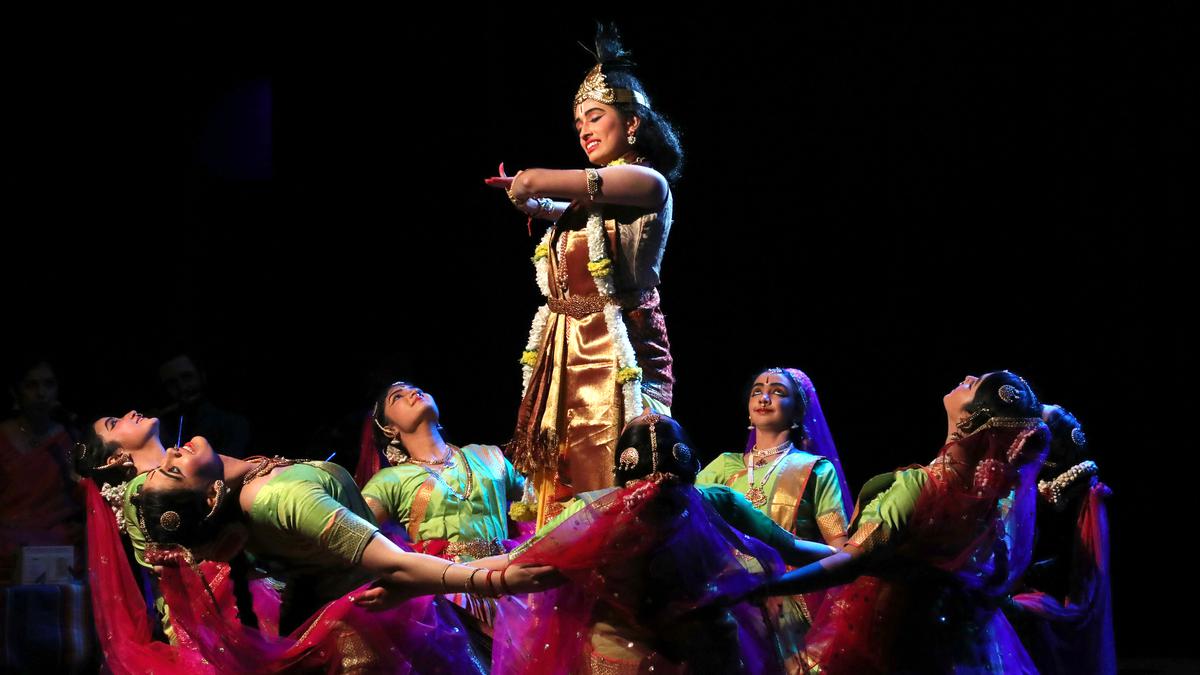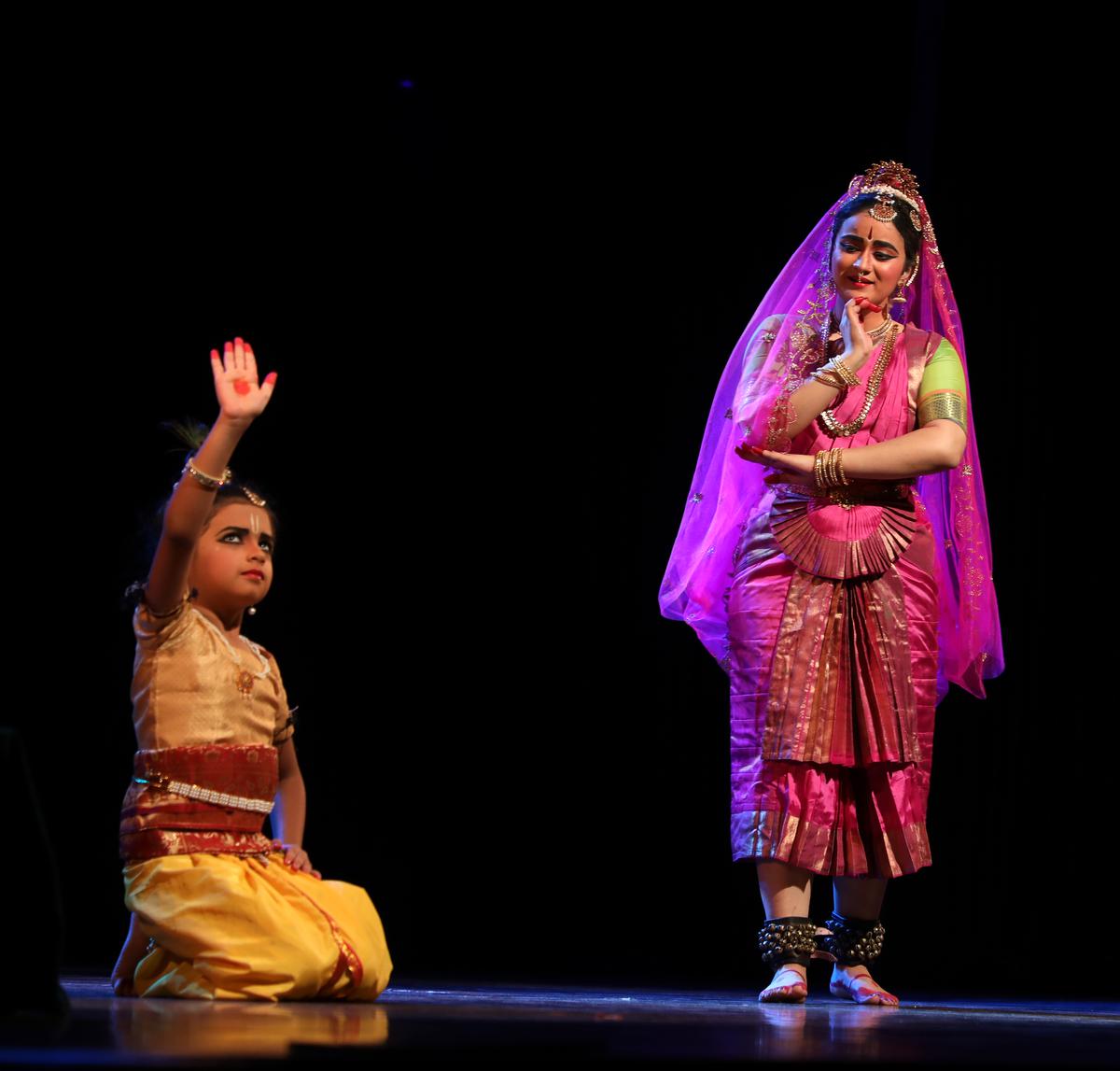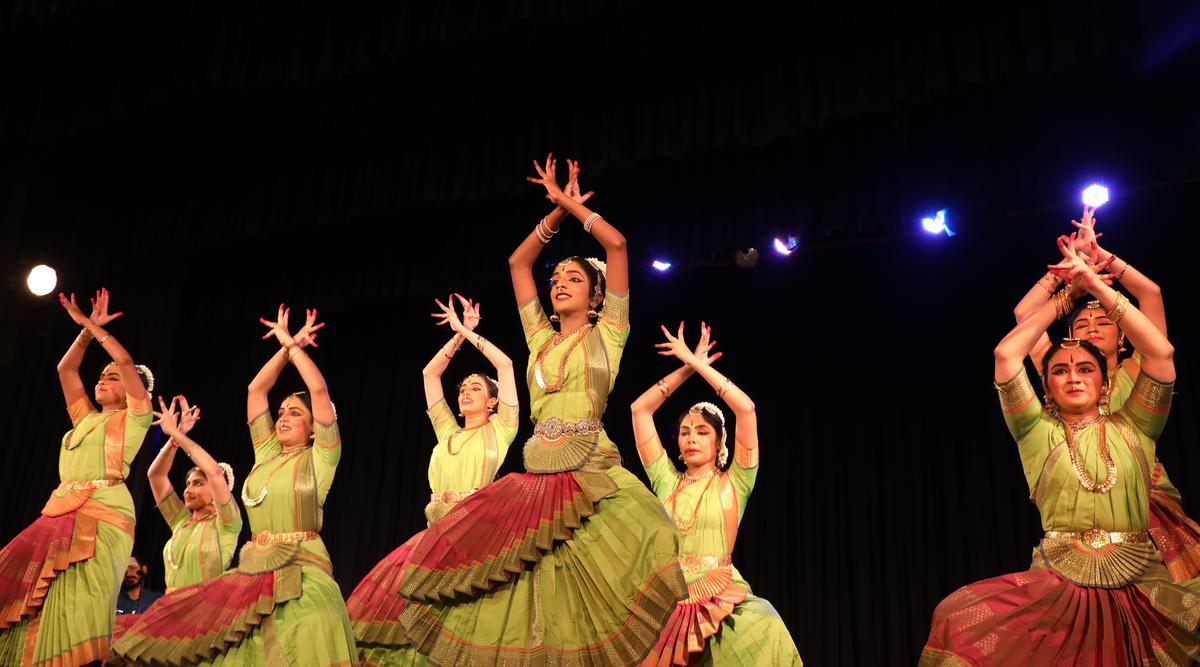- July 26, 2023
‘Pibare Krishna Rasam’ highlighted the emotional pull of Krishna leelas

We’ve seen Sumitra Nitin as a Bharatanatyam dancer and a Carnatic musician in Chennai, but not as a teacher. Her music and dance school ‘Natyasruti’ in Bengaluru that completed 20 years, presented ‘Pibare Krishna Rasam’ recently at Bharatiya Vidya Bhavan under the auspices of Kartik Fine Arts. The melodies on Krishna is a family heirloom of sorts — composed by Sumitra’s dancer-scholar mother, Sujatha Vijayaraghavan, and sung by her grandmother, the well-known Carnatic musician Ananthalakshmi Sadagopan, about 55 years ago for a programme in Delhi.
Naturally, the music was a standout; Sumitra had big boots to fill. She skilfully switched between performing nattuvangam and singing, assisted in the latter by vocalist Yoga Keerthana. She had a stellar group of musicians for support — Vinay Nagarajan (mridangam), Karaikal Venkatasubramaniam (violin), J.B. Sruti Sagar (flute) and Santhosh Heggade (tabla). The live orchestra was a treat.
Students Natyasruti in ‘Pibare Krishna Rasam’
| Photo Credit:
Akhila Easwaran
Choice of songs
Most interesting was the choice of songs, melody must have been the criterion, as not all were common dance songs. Tyagaraja’s Arabi pancharatna keerthana ‘Sadhinchane’ was a surprise inclusion, but Sumitra explains that Guru Vazhuvoor Ramiah Pillai had choreographed it as a varnam for Kamala and Rhadha. There were also ‘Thaye’, ‘Theerada Vilayattu Pillai’ and Andal’s ‘Vaaranamayiram’. These were new to the Bharatanatyam repertoire in the 1960s.
Sumitra had retained the repertoire; except for ‘Sadhinchane’, which was longer than the original, she kept to the same number of repetitions of the lines of every composition. The visualisations were Sumitra’s, as they had no visual recording of the past performances.
Perhaps a first, Sujatha had introduced Kathak in an all-Bharatanatyam show. The duration of two hour fifteen minutes, too long by today’s standards, was the norm back then.

From ‘Pibare Krishna Rasam’
| Photo Credit:
AKHIILA EASWARAN
Talented students
Can anything be more charming than Krishna leelas, especially when there are children around? The 16 Natyasruti young artists displayed excellent rhythm and coordination. Restricted as they might have been with the stage space, their cues and costume changes were perfect.
‘Pibare..’ commenced with a brisk ‘Krishnam kalaya sakhi Sundaram’ (Mukhari, Adi, Narayana Theertha) on Balakrishna. The Periazhwar paasuram ‘Thamugatthuchutti’ when Yashoda (Kritika Radhakrishnan) calls the moon to see her crawling Krishna (Tara Srikrishna), who is excited to see it, was next. The baby had grown into a toddler. Both dancers were well-tutored, but one found the role play and the narrator together distracting, maybe they can alternate. The bright-eyed little child beckoning to the moon, understandably took precedence.
The medley of songs on his childhood pranks was a happy sequence presented by Kritika, Avni, Meenakshi Ajay (Krishna performing Kathak), Pratiksha, Chitrangada and Aditi. ‘Kasthvam bala’ sloka from Krishna Karnamritham when Krishna explains tongue-in-cheek to the gopi (Nandhitha Bharadwaj) why his hand was in the butter pot- looking for a missing calf; ‘Thaye Yashoda’ by Oothukadu Venkata Subbaier (Thodi) and ‘Maiyya Mori’ (Surdas) were the others. Delightful episodes they were. The song transitions, the Kathak tihais (visualised by Guru Sri. Murari Sharan Gupta, delivered by Santhosh) and the rendering of the kavit by Sumitra, were deft.

Tyagaraja’s composition
‘Sadhinchane’ was a pleasure, sung beautifully and interspersed with fast-paced lilting Vazhuvoor-type of jathis. The treatment was reverential- short sancharis with soft, unobtrusive accompaniment and lilting Vazhuvoor jathis during pauses in song- the song was always centrestage. The jathis were a bit fast, so fast for the movements, which tend to suffer. The freize at the beginning with Krishna in many stages of his life and Tyagaraja in the middle, and repeated again in the end, was a great touch. Execution by Krithika, Lakshmi, Srinidhi, Nandhitha, Saundarya, Sanchitha, Maanasi and Smayaa, was well-rehearsed. The Padmanabha freize at the back with dancers seated in front and emoting was an inspired moment.
After this heavy duty piece, ‘Theeraadha vilayaattu pillai’ (Subramanya Bharathi) with similar pranks felt repetitive, though the dancers (Avni as Krishna, Pratiksha, Chitrangada and Aditi) were spontaneous. In ‘Vaaranamayiram’ (ragamalika, Adi), Andal’s (Srinidhi S) detailing of her dream wedding rituals was meticulous and sung soulfully. It was a solemn moment in the action-packed programme.
Krishna’s raas with the gopis and a special Kathak duet with Radha (Sanchitha Shenoy and Nithya Shakti) made the Jayadeva Ashtapadi ‘Chandana Charchitha’ lively. It was performed by Krithika, Nandhitha, Saundarya, Maanasi, Smayaa, Chitrangada, Aditi and Pratiksha.
‘Balia Manege’ of Purandara Dasa and ‘Baro Krishnayya’ by Kanaka Dasa and the Meera bhajan, ‘Hari Thum Haro’ sung MS style in a meditative, pleading Darbari Kaanada, and portrayed by Radha’s granddaughter Saundarya S, soared in its music and the dancer’s soft presence. This segment was solely devotional.
‘Pibare..’ closed with a verse from the Bhagavat Gita ‘Advesta sarva-bhutanam’ praising a bhakta who is ‘free from malice, friendly and compassionate…’ The emotional pull of Krishna leelas was the highlight of this musical, visual journey.




